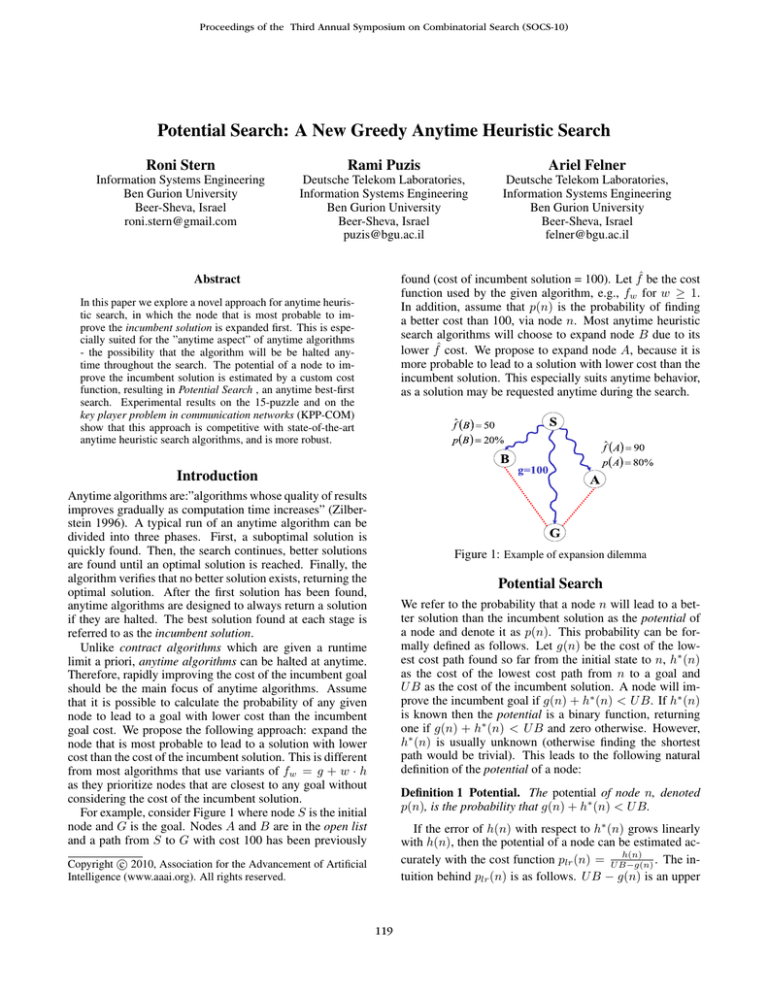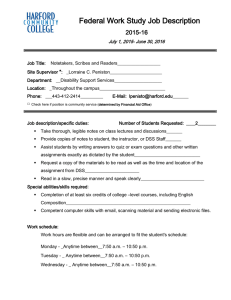
Proceedings of the Third Annual Symposium on Combinatorial Search (SOCS-10)
Potential Search: A New Greedy Anytime Heuristic Search
Roni Stern
Rami Puzis
Ariel Felner
Information Systems Engineering
Ben Gurion University
Beer-Sheva, Israel
roni.stern@gmail.com
Deutsche Telekom Laboratories,
Information Systems Engineering
Ben Gurion University
Beer-Sheva, Israel
puzis@bgu.ac.il
Deutsche Telekom Laboratories,
Information Systems Engineering
Ben Gurion University
Beer-Sheva, Israel
felner@bgu.ac.il
found (cost of incumbent solution = 100). Let fˆ be the cost
function used by the given algorithm, e.g., fw for w ≥ 1.
In addition, assume that p(n) is the probability of finding
a better cost than 100, via node n. Most anytime heuristic
search algorithms will choose to expand node B due to its
lower fˆ cost. We propose to expand node A, because it is
more probable to lead to a solution with lower cost than the
incumbent solution. This especially suits anytime behavior,
as a solution may be requested anytime during the search.
Abstract
In this paper we explore a novel approach for anytime heuristic search, in which the node that is most probable to improve the incumbent solution is expanded first. This is especially suited for the ”anytime aspect” of anytime algorithms
- the possibility that the algorithm will be be halted anytime throughout the search. The potential of a node to improve the incumbent solution is estimated by a custom cost
function, resulting in Potential Search , an anytime best-first
search. Experimental results on the 15-puzzle and on the
key player problem in communication networks (KPP-COM)
show that this approach is competitive with state-of-the-art
anytime heuristic search algorithms, and is more robust.
Introduction
Anytime algorithms are:”algorithms whose quality of results
improves gradually as computation time increases” (Zilberstein 1996). A typical run of an anytime algorithm can be
divided into three phases. First, a suboptimal solution is
quickly found. Then, the search continues, better solutions
are found until an optimal solution is reached. Finally, the
algorithm verifies that no better solution exists, returning the
optimal solution. After the first solution has been found,
anytime algorithms are designed to always return a solution
if they are halted. The best solution found at each stage is
referred to as the incumbent solution.
Unlike contract algorithms which are given a runtime
limit a priori, anytime algorithms can be halted at anytime.
Therefore, rapidly improving the cost of the incumbent goal
should be the main focus of anytime algorithms. Assume
that it is possible to calculate the probability of any given
node to lead to a goal with lower cost than the incumbent
goal cost. We propose the following approach: expand the
node that is most probable to lead to a solution with lower
cost than the cost of the incumbent solution. This is different
from most algorithms that use variants of fw = g + w · h
as they prioritize nodes that are closest to any goal without
considering the cost of the incumbent solution.
For example, consider Figure 1 where node S is the initial
node and G is the goal. Nodes A and B are in the open list
and a path from S to G with cost 100 has been previously
Figure 1: Example of expansion dilemma
Potential Search
We refer to the probability that a node n will lead to a better solution than the incumbent solution as the potential of
a node and denote it as p(n). This probability can be formally defined as follows. Let g(n) be the cost of the lowest cost path found so far from the initial state to n, h∗ (n)
as the cost of the lowest cost path from n to a goal and
U B as the cost of the incumbent solution. A node will improve the incumbent goal if g(n) + h∗ (n) < U B. If h∗ (n)
is known then the potential is a binary function, returning
one if g(n) + h∗ (n) < U B and zero otherwise. However,
h∗ (n) is usually unknown (otherwise finding the shortest
path would be trivial). This leads to the following natural
definition of the potential of a node:
Definition 1 Potential. The potential of node n, denoted
p(n), is the probability that g(n) + h∗ (n) < U B.
If the error of h(n) with respect to h∗ (n) grows linearly
with h(n), then the potential of a node can be estimated ach(n)
curately with the cost function plr (n) = U B−g(n)
. The intuition behind plr (n) is as follows. U B − g(n) is an upper
c 2010, Association for the Advancement of Artificial
Copyright Intelligence (www.aaai.org). All rights reserved.
119
Figure 2: 15-puzzle, solution quality Vs. Runtime
bound on the distance to a goal from node n that may improve the incumbent solution.1 h(n) is a lowerbound on the
search distance to a goal from n. Therefore a node with low
h(n)
U B−g(n) is more likely to improve the incumbent goal cost.
It can be proven that if h∗ (n) = X · h(n) for an independent random variable X, then using plr as the cost function
that determines which nodes are expanded next, results in an
expansion order that is exactly the same as using p(n). Potential Search is a best-first search implementation that uses
plr as a cost function. Note that until the first path to a goal
is found U B is unknown, and some search algorithm that
can find a solution quickly will be used (e.g. WA∗ ).
Figure 3: KPP-COM, 600 nodes, density 2
(GBC) (Everett and Borgatti 1999) in a graph. GBC is a
metric for centrality of a group of nodes which is ratio of
shortest paths that pass through these group of nodes. This
problem has several real-life applications in networking and
security. While this problem is NP-Complete, search techniques can be used to find high quality solutions. In addition
there exists effective admissible heuristics for this problem,
see (Puzis, Elovici, and Dolev 2007) for more detailed discussion on this heuristic and the KPP-COM problem. In
addition, besides Potential Search , AWA∗ and OS we also
experimented with DFBnB in this domain.
Since the main motivation for KPP-COM problem is in
communication network domains, scale free graphs generated according to the Barabasi-Albert model (Barabasi and
Albert 1999) were used in our experiments. This model is
a well-used model of Internet topology and the web graph.
Figure 3 presents a small representing subset of the experiments, displaying the average results on 100 different graphs
with 600 nodes, density of 2 and a desired group size of 20.
The x-axis denotes the runtime and the y-axis the solution
quality (best utility found divided by the optimal utility).
As can be seen, Potential Search outperforms all other algorithm, albeit only slightly better than DFBnB.
There are many future direction for this work. Improving potential function to incorporate search effort, solution
quality estimates as well as more complex error functions is
one such direction. Another direction is to combine Potential Search with a contract algorithm when some knowledge
of the halting time is given.
Experimental results
We first evaluated the performance of Potential Search on
the standard 100 random instances of the 15-puzzle. We
compared Potential Search to AWA∗ (Hansen and Zhou
2007) and Optimistic search (Thayer and Ruml 2008) (labeled hereafter as OS). AWA∗ is an anytime variant of WA∗
that continues to run WA∗ with the same weight even after
a solution is found. OS uses two cost functions: an admissible heuristic h and an inadmissible heuristic ĥ that more
accurately estimates the cost to the goal. OS chooses to expand the node with the lowest g + ĥ, but switches to using
g + h if all the nodes in the open list will not improve the
incumbent solution according to ĥ. In our experiments we
used ĥ = w × h with w values of 1.1, 1.3 and 2 where h is
Manhattan Distance. WA∗ with the same weights was used
for finding the first solution in Potential Search (the cost of
this solution was then used to initialize U B).
Figure 2 shows the results of Potential Search Vs. OS.
The x-axis denotes the runtime in milliseconds, and the yaxis displays the solution quality (the cost of goal found divided by the optimal goal cost). The X mark at the rightmost point of the x-axis denotes the runtime required for
A∗ to find the optimal solution. As can be seen, when using
the same weight Potential Search always outperforms Optimistic Search. In this domain, AWA∗ and Potential Search
displayed similar performance.
Our second test domain is the key player problem in
communication networks (KPP-COM) (Puzis, Elovici, and
Dolev 2007). This is the problem of finding the set of
k nodes with the highest group betweenness centrality
References
Barabasi, A. L., and Albert, R. 1999. Emergence of scaling in
random networks. Science 286(5439):509–512.
Everett, M. G., and Borgatti, S. P. 1999. The centrality of groups
and classes. Journal of Mathematical Sociology 23(3):181–201.
Hansen, E. A., and Zhou, R. 2007. Anytime heuristic search. J.
Artif. Intell. Res. (JAIR) 28:267–297.
Puzis, R.; Elovici, Y.; and Dolev, S. 2007. Finding the most prominent group in complex networks. AI Commun. 20(4):287–296.
Thayer, J. T., and Ruml, W. 2008. Faster than weighted a*: An
optimistic approach to bounded suboptimal search. In ICAPS, 355–
362.
Zilberstein, S. 1996. Using anytime algorithms in intelligent systems. AI Magazine 17(3):73–83.
1
We assume here a domain with unit edges cost, but this can be
easily generalized.
120




